
Commercial Real Estate: Finding the Next Shoe to Drop
Macroeconomic Conditions
The post-pandemic economy has had to contend with a rarely seen number of short-term disruptions and fundamental shifts to which it has mostly taken in stride. So far, we have avoided a widely broadcast recession, helped initially by huge amounts of pandemic related financial aid, and followed by a historically strong labor market that has kept consumption alive. However, the inflationary side effects of all this economic activity has forced the Fed to take away the punchbowl, turn the music off, switch the lights on, and launch the most aggressive rate hiking cycle in recent history. Combining this with geopolitical related overhauls of global supply chains and fundamental changes in the way people work, it seems that the generally strong economic conditions of 2021 and 2022 were living on borrowed time. One of the first signs that the clock was winding down was this Spring’s regional banking crisis which drove investors and analysts to search for the next shoe to drop in a dynamic, but likely not dynamic enough, economy. Commercial real estate (CRE) assets, particularly offices, quickly became the topic of focus. Faced with a departure from near zero interest rates, which had become a hallmark of the industry, and a shift away from in person to remote work, CRE seems a worrisome candidate to fill the role. Fortunately, most credits appropriate for cash portfolios are relatively insulated from this market.
Brief History of Commercial Real Estate (CRE) Market
In 2012, post-financial crisis commercial real estate lending bottomed out at an estimated $3.25T of loans outstanding. Since then, CRE lending has expanded to just under $6.0T, as of the end of 2022. Population and economic growth from 2012 to 2022 provided a tailwind to commercial properties of all types. During this time, low interest and interest-only loans, which allow borrowers to make only interest payments on commercial mortgages during the life of the loan, acted as an afterburner accelerating growth. Interest-only loans at near-zero rates made them attractive for levered real estate transactions, growing from 17% of loans backing commercial mortgage-backed securities in 2010 to 85% in 2022. The idea is that when the principal payment comes due, it will be paid either by refinancing at another low rate or by selling the building.
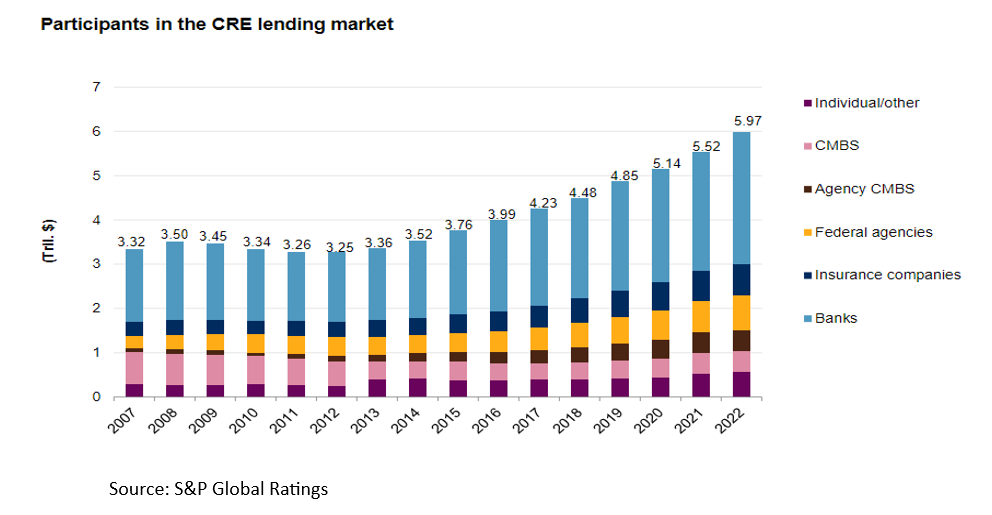
Post-Pandemic Commercial Real Estate Environment
Remote and hybrid work has drastically changed commercial real estate economics, jeopardizing the previously listed options. Of all workers who can effectively work remote, 76% of them do so for at least a portion of the week. This has drastically reduced foot traffic in central business districts which has risen slightly from pandemic lows but remains well below the pre-pandemic foot traffic that large office spaces were built for. You can see this in the daily subway ridership in New York City which is yet to cross 3.5M riders or ~ 77% of pre-pandemic levels.
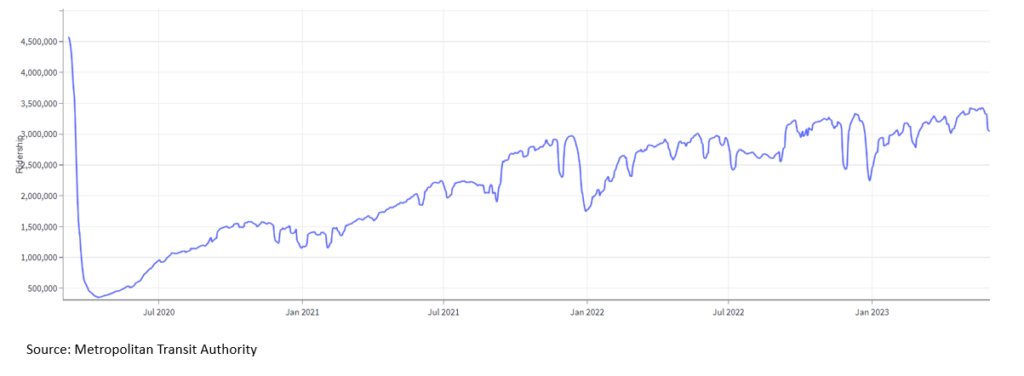
Additionally, office vacancy levels hit a record high of 17.4% in Manhattan in April of this year as companies dumped excess office space, finding themselves with no need to provide desks for their entire workforce. This has driven a number of high-profile office building mark downs. For example, excess office space supply drove Mitsubishi UFJ to sell their 22-story office at 350 California St. in San Francisco for $67.5M, ~ 75% below the $250M initial asking price in 2020. Similarly, Blackstone wrote down the value of its investment in Chicago’s Willis Tower by 29% which the New York Times reported was 17% vacant in December. This combination of rapidly falling property prices and rates sitting at 15-year highs limits the ability of property owners to sell or refinance their investments at economically viable levels.
Current Worries and What Problems May Arise
This reality has elevated worries that there could be widespread defaults of commercial real estate office loans. These forces drove Brookfield Properties to default on a $750M loan tied the Gas Company Tower and 777 Tower in Los Angeles. While banks and borrowers will likely work to either extend the term of troubled loans so they can be refinanced at lower rates, or work out some other solution, current conditions have caused banks to shy away from CRE. Moreover, tighter lending conditions for CRE loans similar to pandemic conditions has coincided with a rise in commercial real estate loan charge-off rates.
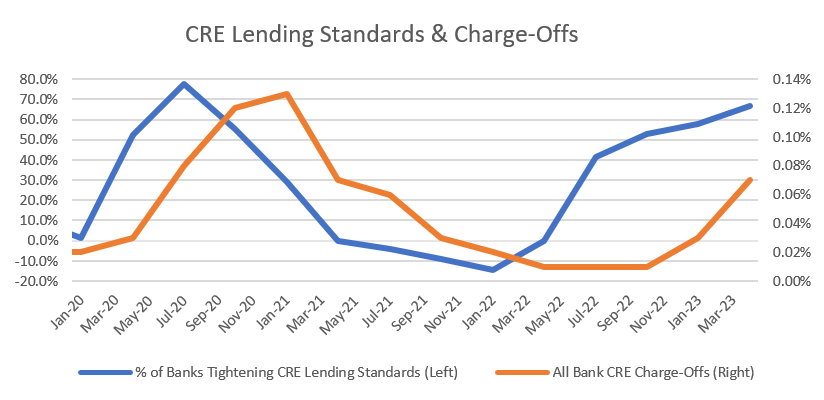
If banks become unwilling to refinance CRE loans, this could place more financial pressure on these assets, leading to a downward spiral where commercial real estate, particularly office space, becomes distressed. This may cause banks to further reduce their credit availability and lead to more financial stress. While commercial real estate has taken the spotlight in recent months, it is important to note that many forms of commercial real estate assets, such as multi-family and industrial loans, continue to benefit from strong economic tailwinds.
Additionally, for the most part, asset quality at banks remains better than before the pandemic, and they have been aggressively building reserves in anticipation of a broader economic slowdown which would help shield them from possible issues in the commercial real estate market to an extent. However, commercial real estate lending is not evenly distributed across the economy or the banking system.
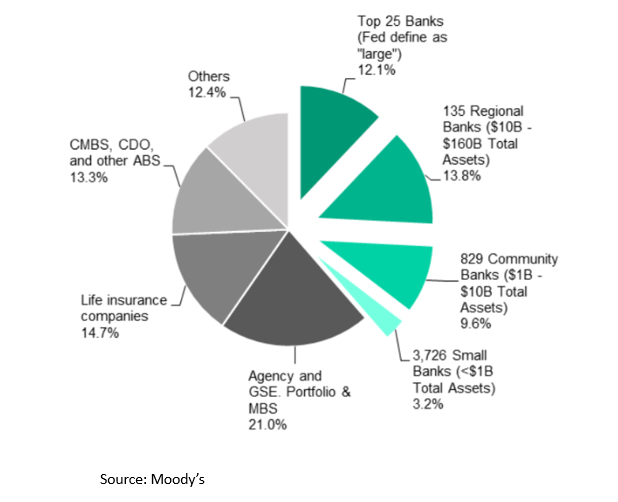
Moody’s estimates that banks hold just below 39% of debt backed by multi-family and other commercial real estate assets, and the majority of this is concentrated in banks with greater than $10B of assets. Focusing on this group, we see that not all banks have an equal appetite for commercial real estate lending either as a whole, or for assets which are facing headwinds. JPMorgan released a report comparing banks’ commercial real estate exposure relative to their capital levels, focusing on areas in which stress is mounting. They concentrated on banks’ commercial real estate exposure, for example, safer assets, like owner-occupied and multi-family buildings. This highlighted the concentration of potentially troublesome commercial real estate assets at mid-sized, regional banks.
Bank Commercial Real Estate Exposure
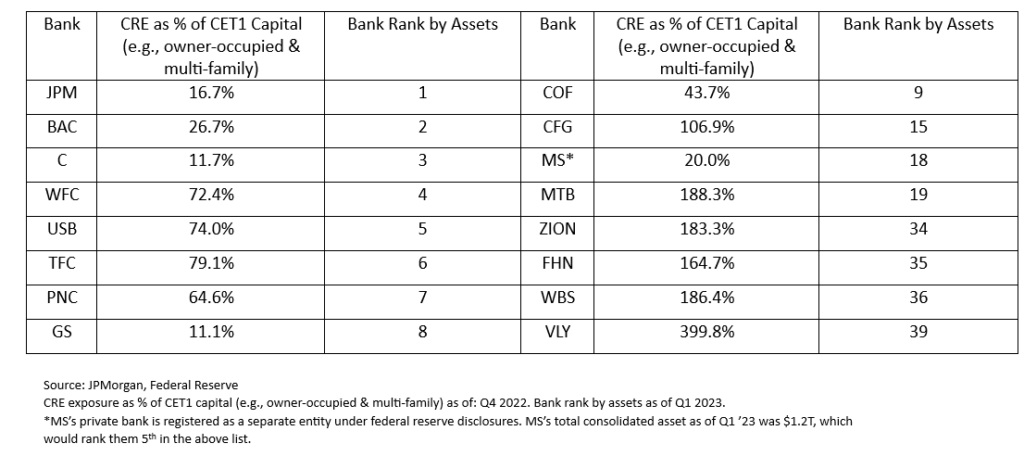
Looking Ahead
This is an admittedly small list, as banks’ exposure to commercial real estate varies greatly. However, generally speaking, smaller banks have larger and more geographically concentrated CRE exposure, placing them at greater risk of running into issues if asset quality were to deteriorate. Nonetheless, cash investors may find solace that large, systemically-important banks appropriate for cash portfolios have relatively low commercial real estate exposure compared to their capital levels. Additionally, threatened commercial real estate categories, such as office space, only make up a portion of their overall exposure. While commercial real estate will remain in the news as the market adapts to new ways of living and working, it is appropriate to monitor commercial real estate at the moment rather than sound the alarm.
Please click here for disclosure information: Our research is for personal, non-commercial use only. You may not copy, distribute or modify content contained on this Website without prior written authorization from Capital Advisors Group. By viewing this Website and/or downloading its content, you agree to the Terms of Use & Privacy Policy.
